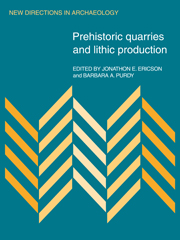Book contents
- Frontmatter
- Contents
- List of contributors
- Dedication
- Part 1 Introduction
- Part 2 Procurement, production, and exchange
- Part 3 Technology and techniques
- 10 Jigsaw: reconstructive lithic technology
- 11 Quarry studies: technological and chronological significance
- 12 Characterization of selected soapstone sources in southern New England
- 13 Reconstructing Corbiac: the context of manufacturing at an Upper Paleolithic quarry
- Index
13 - Reconstructing Corbiac: the context of manufacturing at an Upper Paleolithic quarry
Published online by Cambridge University Press: 04 August 2010
- Frontmatter
- Contents
- List of contributors
- Dedication
- Part 1 Introduction
- Part 2 Procurement, production, and exchange
- Part 3 Technology and techniques
- 10 Jigsaw: reconstructive lithic technology
- 11 Quarry studies: technological and chronological significance
- 12 Characterization of selected soapstone sources in southern New England
- 13 Reconstructing Corbiac: the context of manufacturing at an Upper Paleolithic quarry
- Index
Summary
Quantitative analysis of lithic technological attributes enables the reconstruction of stone-tool-making behavior at the Upper Paleolithic quarry of Corbiac. These attributes display a consistent and uniform appearance characterized by low variability. This observation is used as the basis for suggesting that the Evolved Perigordian component of Corbaic may have been produced by a group of socially related, part-time, flintknapping specialists. The ramifications of such a possibility for lithic studies in general and models of Upper Paleolithic social systems in particular are considered.
Introduction
The Upper Perigordian quarry of Corbiac is in the Central Perigord region of southwestern France near the town of Bergerac (LaVille, Rigaud & Sackett 1980, fig. 6.2). Excavations at the site were directed by François Bordes from 1962 to 1967 (Bordes 1968). The upper stratum (Level 1) yielded an estimated 100,000 blades, over 1,000 cores in various stages of reduction, and approximately 10,000 finished tools (Bordes & Crabtree 1969, 1). Based on the abundance of microgravettes, Gravettian points, and dihedral burins, Bordes judged the Level 1 assemblage to be transitional between Perigordian VI and proto-Magdalenian, and suggested a relative date of c. 20,000 b.c. for it. He called the assemblage Evolved Perigordian, because it exhibited Upper Perigordian and proto-Magdalenian traits. This assemblage had an important role in the argument that was advanced that the latter industry was the terminal phase of Perigordian development (Bordes & De Sonneville-Bordes 1966; LaVille, Rigaud & Sackett 1980).
- Type
- Chapter
- Information
- Prehistoric Quarries and Lithic Production , pp. 139 - 146Publisher: Cambridge University PressPrint publication year: 1984



